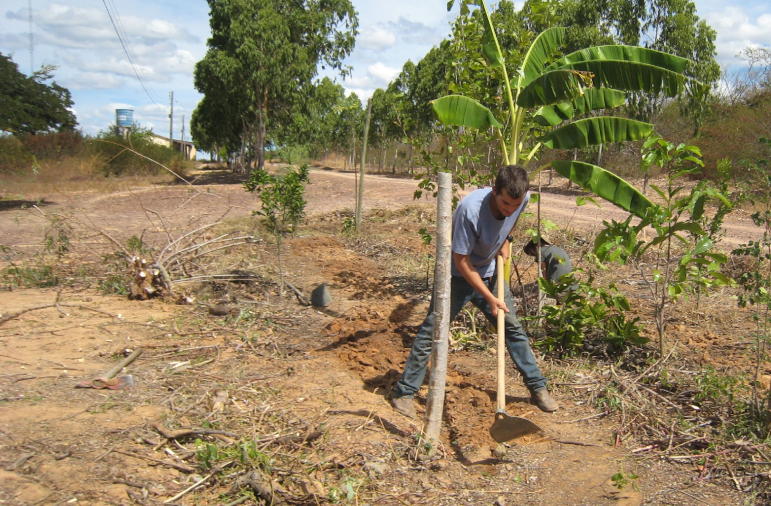Copyright Resilience

How it all started The Instituto Anjos do Sertão is a non-profit family organization based in Canto do Buriti, Brazil. Founded in December 2015 by a Brazilian family, it combines a holistic vision with educational programs in regenerative farming and a research center – all centered around a 5,500-hectare regenerative school farm. Its story begins in 2008 when the founders of Anjos do Sertão purchased the land in the Caatinga region – a unique and neglected biome in the Northeast Region of Brazil. Immediately they faced a critical lack of skilled local labor to work on the farm. This challenge revealed a deeper issue and sparked the idea that would later become a center of their project: to train and motivate people in the community to work with agriculture, thereby creating a skilled workforce that could benefit the entire region and improve the income of the families. It was at this pivotal time that Arthur Graziano, one of the founders’ sons, returned to Brazil from his travels across Asia. His journey had taken him to an Indian ashram, where local monks practiced regenerative farming and holistic living. The philosophy of working with nature, rather than against it, resonated with him deeply. He arrived home determined to bring these lessons back. Determined to create a similar sanctuary, Arthur together with his family founded a place dedicated to the recovery of the biome and the support of local communities – and that’s how Anjos do Sertão – Angels of the Backlands – was born. Anjos do Sertão family in the regenerative cashew plantation Caatinga – a forgotten treasure Despite the Amazon rainforest being the first ecosystem that probably comes to mind when thinking about Brazilian nature, Brazil is home to an astonishing variety of biomes. Caatinga, commonly known as the “white forest” of the Northeast, is one of the most overlooked. At first glance, it might seem barren – a seemingly endless stretch of sand dunes and parched trees – and that is certainly how it looks for half the year. But once the rains come, this semi-arid landscape transforms overnight. The first drops of water bring Caatinga to life, and suddenly it blooms in a burst of green. Found only in one place on earth, Caatinga is a land of extremes. With its scorching daytime temperatures (30-40°C) and less than one month of rain per year, it has developed astonishing resilience. Despite being often mistaken for a desert, it’s far from lifeless: jaguars, armadillos, snakes, countless insects and reptiles have adapted to its harsh rhythms. The biome consists of unique and ingenious trees that have discovered different ways to thrive in these conditions. For example, the umbu tree (Spondias tuberosa) also known as Brazilian plum has a root system that can store up to 3,000 liters of water in potato-like tubers. The much-loved cashew tree originated in this biome too – its deep taproots scavenge every drop of moisture from the soil. But the most interesting part of this biome is how all the different trees work together. Like a fungal mycelium network, their shallow roots intertwine, sharing water and nutrients, working together and supporting each other, forming a community to survive. Unfortunately, Caatinga is currently under threat of disappearing. Like in many similar stories, the problems stem from monoculture farming, which over the years has caused soil degradation, leaving scars on this vulnerable land. Fields were plowed, eroded, and then abandoned by farmers, too damaged to recover on their own. These pressures are compounded by deforestation driven by global demand for valuable hardwood and the devastating impact of overhunting local wildlife. For decades, this biome was seen as “unproductive” and useless – only recently has its ecological importance been recognized, with some attempts now being made to recover it. The family of Anjos do Sertão chose the Caatinga not despite its challenges, but because of them. They believed this modest environment held much hidden knowledge: if regeneration could work here, it could work anywhere. But first, they had to earn the trust of the people who knew this land best… Immersion at Anjos do Sertão School-Farm for agroforestry course. View from above while preparing a new area Seeds of Ancient Knowledge Besides its peculiar flora and fauna, the Caatinga is also home to some of Brazil’s most marginalized communities, with one of the lowest human development indexes in the country. For generations, families here have endured harsh droughts, political neglect, and broken promises. People are scattered across vast, isolated stretches of land and don’t trust strangers. The Anjos do Sertão family learned this the hard way. In the early days, when they first approached local small-scale farmers, the reception was icy. People were skeptical, asking, ‘What do you need from us?’ The skepticism was earned – decades of empty projects had left them exhausted. Promises of “development” often ended in exploitation, leaving the land worse off than before. But the family wasn’t there to preach or profit. For several years, they simply listened. They traveled from community to community, getting to know people better, building connections, and learning what kind of help was truly desired. The answer was clear: people were looking for ways to improve their families income. However this goal was not easy to reach. The primary obstacle was not a lack of ideas, but a fundamental challenge in people’s mindset. At the time, many locals received government financial aid for the unemployed. While this program had been essential in helping families climb out of hunger, it had an unintended consequence: it fostered a dependency mindset, making many reluctant to invest additional effort to improve their living conditions through work. Faced with this reality, the family decided to shift their initial focus from simply training a workforce to launching regenerative projects that could generate immediate, tangible income. The aim was to make work attractive and financially rewarding again. Collaboration was in the center of this new approach. The communities themselves chose beekeeping as the ideal first project – a low-risk, high-reward activity that required only initial training and minimal ongoing labor, yet provided a valuable new source of income. Jari, beekeeping field coordinator, harvesting honey during the rainy season Slowly, trust began to grow. Institute Anjos do Sertão provided the requested training, found sponsors and equipment, and helped in marketing and selling the honey under their own trademark, while the farmers led the work and simultaneously increased pollinator populations in the region. “These are people who can work with their hands and read the land like a book,” says Arthur, who is responsible for the beekeeping project. “They can predict the exact day the rains will come just by observing bird behavior, know which tree barks can heal fevers or infections, and understand how to coax food from dry soil using techniques passed down for centuries.” The Institute became determined to collect, preserve, and share this traditional knowledge. Today, Anjos do Sertão operates as an open school farm that works with many people from local communities on projects ranging from agroforestry to native tree planting. Together, they’ve already planted over 5,000 native trees, reviving patches of degraded Caatinga. Inside Anjos do Sertão What began as a family project has grown into a full nonprofit hub for nurturing the community and fostering rural entrepreneurship through building the bridge between past and future – taking traditional knowledge and combining it with new bio-technologies. Everyone in the family plays their unique role. The parents of the family – Helmut and Tatjana – work on overall management and fundraising for the projects. Their sons lead the projects of their own: Arthur is responsible for honey production while John manages the training programs at the school farm. Collaboration is a core principle for Anjos do Sertão. The institute partners with urban agricultural schools – offering students to practice their knowledge on their land, getting hands-on experience from their theoretical knowledge. Since joining the Ecosystem Restoration Communities movement in 2023, Anjos do Sertão has tapped into a global network that provides support in volunteer coordination, Monitoring & Evaluation, and the exchange of education and expertise with fellow restoration communities worldwide. Immersion at Anjos do Sertão School-Farm for agroforestry course One of the challenges they constantly face is maintaining a seed bank. Decades of land degradation made finding seeds for native species nearly impossible. Bringing back native trees like the Aroeira (Astronium urundeuva), Faveira (Parkia platycephala), Jatobá (Hymenaea courbaril) and the rare Barriguda (Ceiba glaziovii)hasn’t been easy. Thankfully, there are many people from the local farmers who have preserved them. Now, the family collaborates with them to collect, germinate, and replant these rare species.”You can’t just plant a seed and walk away,” Arthur explains. “Each species requires experiments with water stress, nutrients, and timing to trigger their natural defense mechanisms, their immune systems”. Beekeeping also plays a major role in the farm’s life. The farm hosts native beehives, managed by a dedicated team, and trains locals to start their own apiaries. It creates extra income for families to whom they help to sell honey on their own website, alongside with organic juices and products. Anjos do Sertão grows their own organic food – they’re currently testing nine different agroforestry plots to see which combinations survive drought best before scaling up. Once a method works, they share this knowledge with communities, who spread it further. This way, the effort multiplies and contributes to the reforestation and food security of the whole region. Progress Beyond Plants When asked about the most profound change they’ve witnessed, the family doesn’t point to trees or harvests. They mention the mindset shift. After years of patient work, the local smallholder farmers no longer see nature as an obstacle to overcome. Now, they prefer to unite and work together, understanding bioeconomy and the value of working with ecosystems in an integrated way. They prefer to work with their hands rather than rely solely on financial programs, as it provides both additional income and a sense of dignity and ownership over the land. Two volunteers enjoying the first harvests from agroforestries of Anjos do Sertão “People realize now that you can work with nature, not against it. You can earn a living and heal the land at the same time. You can shape your environment with your own hands – and if you do it in a non-invasive way, the environment responds with gratitude.” The family’s vision for Anjos do Sertão stretches far beyond the farm’s borders. A carbon credit project is planned for 2026, which will fund large-scale native reforestation in partnership with the community. They aim to expand the school farm’s activities and begin a new project on cashew production with local small farmers to further increase community income. The Caatinga’s story isn’t one of survival in a dryland ecosystem – it’s a lesson of looking for the hidden patterns, finding alliances, and being patient. Well, and about fate of course. Because, if a forgotten biome can regrow from dust, what else might be possible? Teaser image credit: Author supplied.



